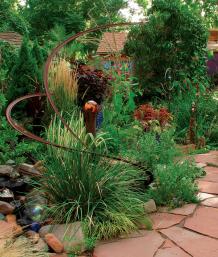
The confines of an average city lot can befuddle ardent gardeners, even more so those obsessive collectors who never tire of adding new plants to their garden. Believe me, I speak from experience. The challenge of finding just the right place where each new find can thrive and the desire for a garden that looks cohesive and artful create a slippery slope that drops away sharply into gardening madness.
Every garden has varied growing conditions, some that are challenging and others that provide unusual opportunities. In the high, dry climate of Denver, Colorado, where I garden, intense sunlight and low humidity is the norm; on a sunny southern exposure, it can create conditions similar to those found in extreme regions of New Mexico or Arizona. By contrast, a shady northern slope—given a bit of compost and extra moisture—will support cool-climate plants, like Japanese maples (Acer palmatum* cvs., USDA Hardiness Zones 5–8), ferns, and hostas (Hosta spp. and cvs., Zones 3–9).
I take full advantage of the different moods created by the distinct plant palettes suited to each exposure. Full sun lets me be bold. Shade allows me a softer touch. Between the two areas, I unite the extremes with a central feature and by echoing elements found in the other two spaces.
Make a statement in the sun
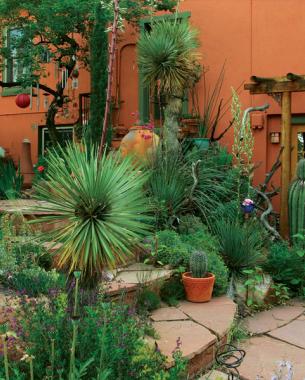
Intense sunlight is the normal state of affairs in much of my yard. Thankfully, there are far more plants that love full sun than I could ever fit into my garden, giving me a vast array to choose from. This part of the design features heat-loving, sun-worshiping plants with bold forms and bountiful flowers.
The spikes of Spanish bayonet (Yucca faxoniana, Zones 6–11) and other yuccas catch your eye, while supporting players, like California poppies (Eschscholzia californica and cvs., annual) and many native penstemons (Penstemon spp. and cvs., Zones 3–10) and sages (Salvia spp. and cvs., Zones 5–11), dress up the sculptural forms, adding color throughout the summer.
Scoria mulch, a gravelly, pumicelike volcanic rock, keeps the crowns of desert plants dry and moderates temperature extremes. It also keeps the soil surface open and receptive to infrequent rain or watering.
I make the most of my hot spots in full sun. A flagstone patio, for example, though shaded by an umbrella during summer’s heat, is a welcome opportunity to soak up some sun when the winter rays stream in at a low angle. Positioning large boulders to absorb the day’s warmth is another way to take advantage of full exposure. The radiant heat the boulders give off at night offers frost protection to plants tucked into crevices along their base, allowing me to grow less-hardy plants. While snow lingers for weeks elsewhere, here it always melts away within hours or days. This part of the garden is also where I stage my collection of tender succulents in pots.
Create a cool counterpoint in shade
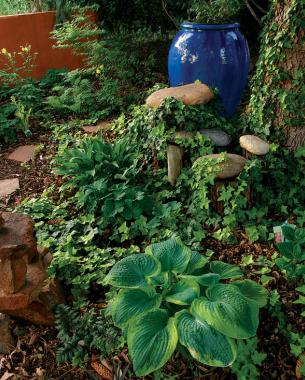
Even a small bit of shade can change everything. Gone are the bristling spikes, as delicate foliage and flowers provide a restful counterpoint to the full-sun garden. With the ground sloping to the north, any sun that peeks through my neighbor’s deciduous trees strikes this part of my garden at an oblique angle, keeping the soil here consistently cool into late spring. Early bloomers emerge late, escaping the random spring freezes common to the region. This allows me, once again, to expand my plant palette and create a different mood in my landscape.
In the shade garden, I use organic mulches of compost, leaves, and decomposing bark to enrich the soil and help retain moisture. Bagged leaves supplied by generous neighbors are strewn about in the fall and decompose by spring, providing extra organic material. This makes it possible to grow shade-loving, woodland plants in our native clay soil.
The result is a sequence of sheltered pockets filled with plants reminiscent of a Pacific Northwest garden. Designed as a woodland path, this area leads to a cool, shady spot, perfect for a seating area that invites you out of the high heat of summer.
A middle ground features the best of both worlds
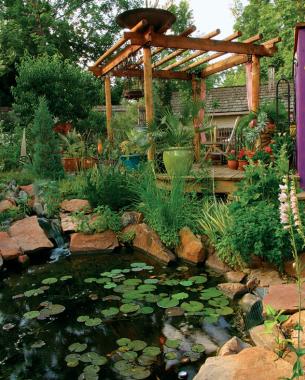
The different look and feel of sunny and shady areas can make it difficult to connect them into a cohesive landscape. I unite these extremes with a middle ground of adaptable plants featuring echoing forms, textures, or colors to create continuity and a dominant feature to complete the design.
The key to a successful transitional zone is its ability to support a palette of plants that unites the garden by relating to the areas that surround it. The bold outlines of kniphofias (Kniphofia spp. and cvs., Zones 5–9) and variegated iris (Iris pallida ‘Variegata’, Zones 4–9) echo the spiky plants in the adjacent hot zone. Similarly, the deep green leaves of Rocky Mountain penstemon (Penstemon strictus, Zones 3–8) harmonize with the more delicate selections in the nearby shade, while their flower spikes link back to the heat-loving penstemons growing uphill. Red flagstone paths provide a unifying hardscape element shared by the sculptural desert on the left; a lush, leafy path on the right; and elements of both set along a stream in between.
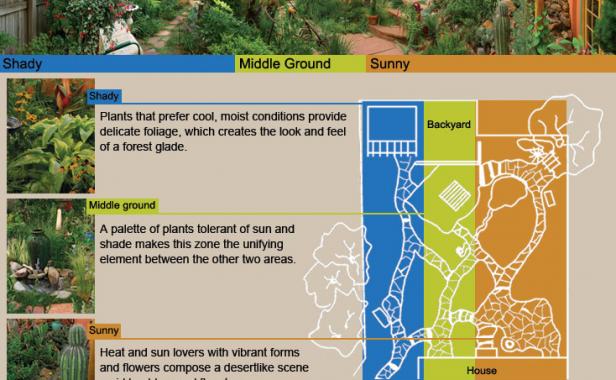
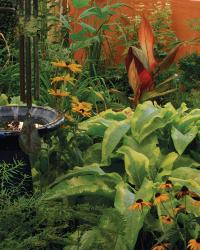
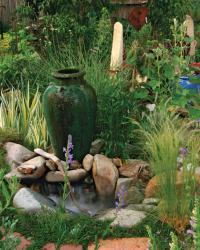
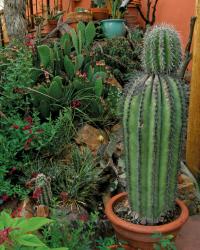



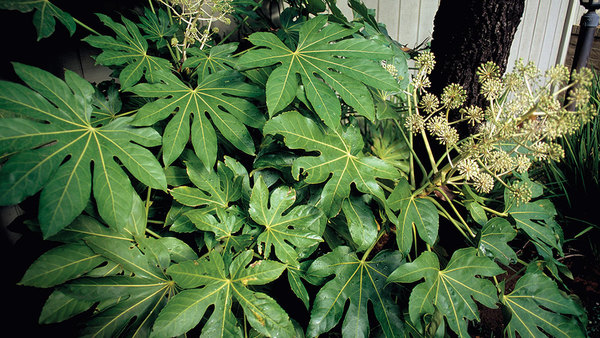




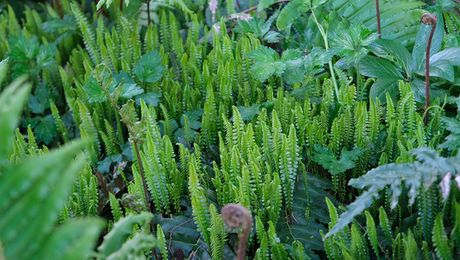










Comments
Log in or create an account to post a comment.
Sign up Log in